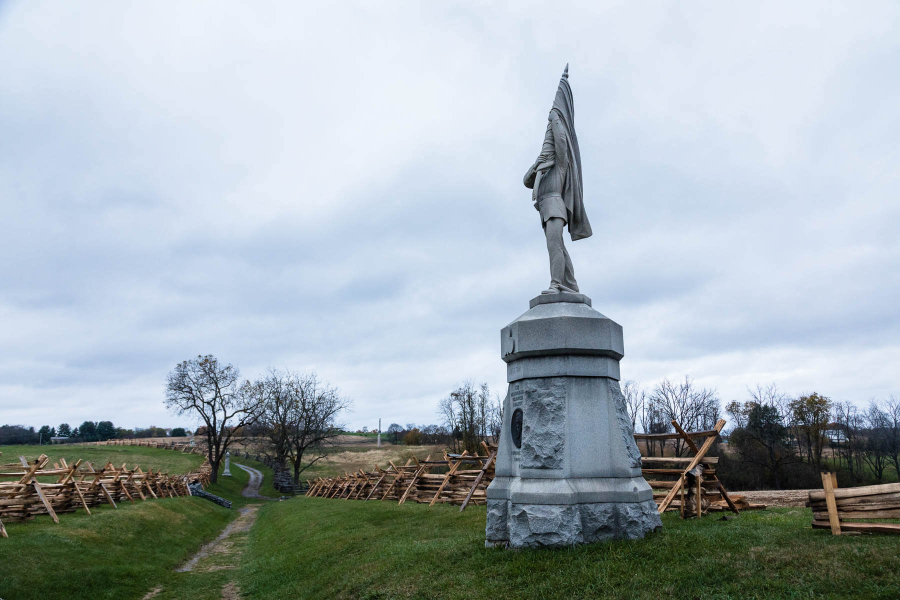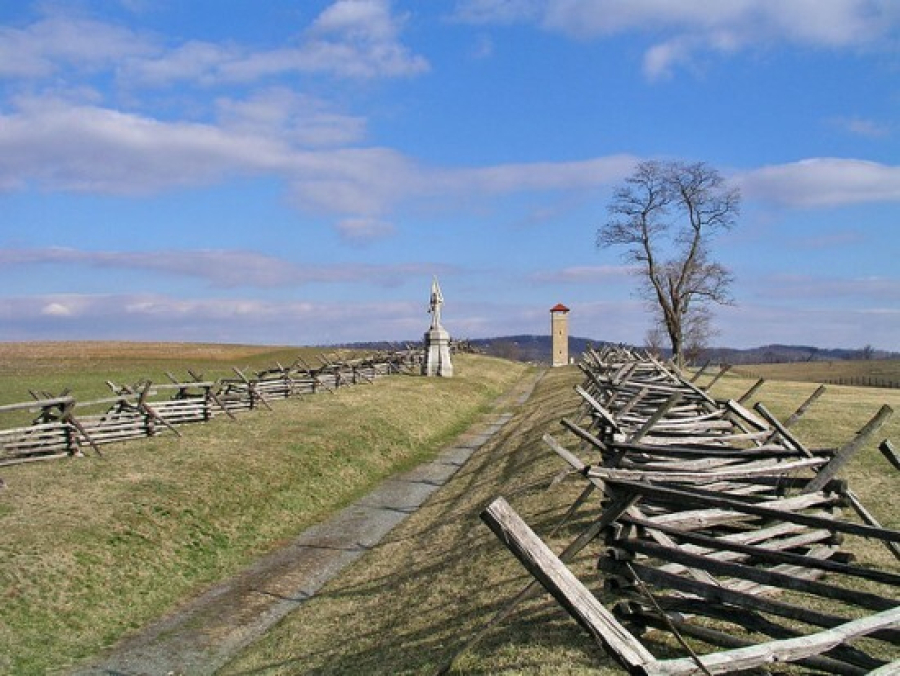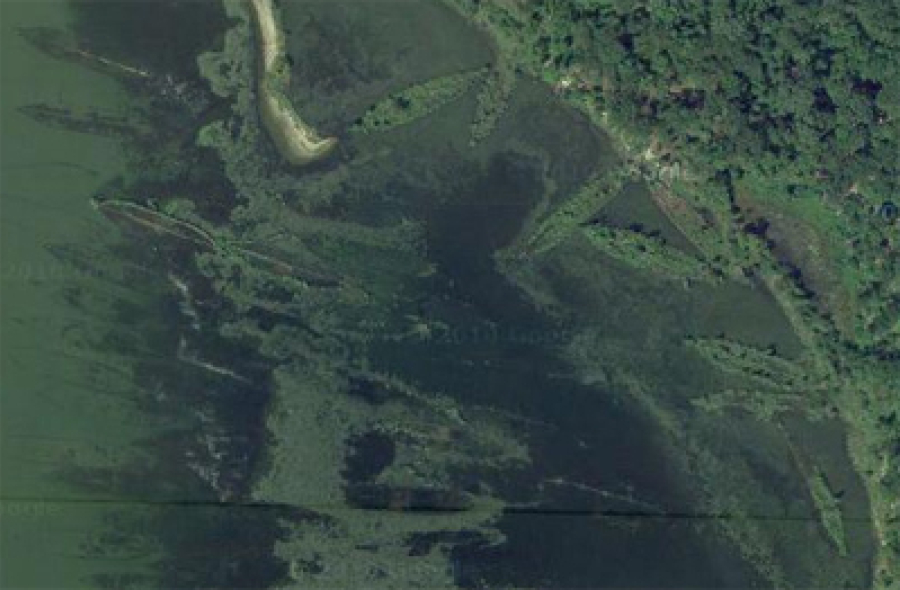BOO!s of the Bay: Nine scary Chesapeake stories
We've compiled an eclectic list of hauntings, sightings and strange spooks from throughout the Bay region.

Look around the Chesapeake Bay watershed in the fall, and you'll find ghost tours all over the place: Annapolis, Gettysburg and Richmond, to name a few.
And why wouldn't there be ghosts here? The Chesapeake region was among the first areas in the United States settled by English colonists. Since that time, the Bay has experienced land-altering and life-taking hurricanes, mysterious shipwrecks, and bloody battles during the nation's early wars.
That’s why we've compiled an eclectic list of hauntings, sightings and purely strange spooks from throughout the Bay watershed. Many of these places would make a perfect outdoor escape – if you’re brave enough, that is!
1. Point Lookout Lighthouse

Located in St. Mary’s County, Maryland, the Point Lookout lighthouse is one of the watershed’s most notoriously haunted sites. It has been featured on the Travel Channel’s Weird Travels and TLC's Haunted Lighthouses. Paranormal reports include strange odors that come only at night and spirits that have saved the lives of park employees living in the house.
After years of reported sightings, smells and sounds, the famous pioneer paranormal researcher Hans Holzer investigated. He recorded 24 different sounds and voices in and around the lighthouse using electric voice phenomena (EVPs).
One of these voices—heard saying, "This is my home"—is suspected to be Ann Davis, wife of the lighthouse's first keeper. Ann maintained the lighthouse long after her husband died. She has been seen standing at the top of the staircase, wearing a white blouse and blue skirt. But she is far from the only apparition people have experienced at the lighthouse.
The lighthouse is now maintained by the state of Maryland and is open only a few times a year. But if you’re really fearless, you can sign up for a Paranormal Night, when small groups can investigate the lighthouse after dark.
2. Point Lookout State Park
It’s true: Point Lookout is so haunted that it earned two spots on our list of spooky places.

Point Lookout's location—a peninsula between the Chesapeake Bay and the mouth of the Potomac River—made it an ideal watch post for spotting British ships during the War of 1812.
Its isolation from the mainland offered little chance of escape for the 50,000 Confederate prisoners held here during the Civil War.
The prisoners of war lived year-round with nothing but canvas tents to protect themselves from mosquito-infested summers and freezing cold winters.
Between 3,000 and 8,000 men died in the camp and were buried in mass graves—many of which are now underwater.
As if that isn't enough, a Civil War hospital was also on the peninsula and housed wounded soldiers from the Battle of Gettysburg.
One of the most frequently seen ghosts at the park is a man in ragged, homespun Civil War clothing, reeking of mildew and gunpowder, and stumbling away from what was once the camp's quarantined smallpox unit. It's thought that the man feigned illness to escape from prison—but it seems he never did...
Brave enough to visit? The Maryland Department of Natural Resources lists information about Point lookout hours, trails and more.
3. Harpers Ferry National Park
Many people on the streets of Harpers Ferry National Historic Park have seen the ghost of abolitionist John Brown. Some say that he’s so realistic that tourists, thinking he is a historic reenactor, ask him to pose for a photograph with him – only to find later that their camera has not captured him.

Brown led an uprising in Harpers Ferry, West Virginia in 1859, raiding the armory with hopes of freeing the South—including his wife and children—one plantation at a time.
When word spread of Brown’s rebellion, Confederate General Robert E. Lee left for Harpers Ferry so quickly that he didn’t even have time to put on his uniform. Lee and his one hundred troops sent Brown to the gallows; however, his proposed revolution would become a catalyst for the Civil War.
But perhaps a more frightening paranormal experience surrounds one of John Brown's opponents, John Wilkes Booth, who visited Harpers Ferry to witness his nemesis’s hanging. Booth stayed in a house known as the "Haunted Cottage."

The house has been the site of 12 deaths and many have witnessed objects disappearing and then reappearing. The house is now the office of the Harpers Ferry Society for Paranormal Research.
4. Civil War battlefields
The Chesapeake Bay watershed states were home to the greatest number of battles in the country's early history. Spanning the border of the North and South, the region was particularly hard-hit during the Civil War.

Left untouched except for the occasional commemorative monument, battlefields in Antietam, Gettysburg and Manassas provide a living museum for school children and history buffs alike.
But public access to these locations also means that there are thousands of reports of wandering soldiers, loud booms in the night, broken cameras, and even entire battles being fought in plain view.
In one alleged incident at Little Round Top in Gettysburg, reenactors working on the film Gettysburg were visited by a man dressed as a Union soldier, who they assumed was also in the movie. He passed them ammunition, which was later discovered to be pristine musket rounds that dated back to the exact time of the famous Civil War battle.
At Antietam—where 23,000 troops were lost during some of the Civil War’s bloodiest battles—a famous creepy spot is Bloody Lane. This old farm road got its nickname after one particularly deadly battle, when thousands of Union and Confederate soldiers were killed and their blood flowed down the road like a river.
5. "Freedom fortress" at Fort Monroe
Perhaps paranormal activity is expected at a military base that has been inhabited since 1608. But one would be hard-pressed to find a line-up of big named spirits anywhere else but Fort Monroe in Hampton, Virginia.

Reported sightings at the base include a young soldier named Edgar Allen Poe, President Abraham Lincoln, Confederate President Jefferson Davis, Chief Black Hawk and Ulysses S. Grant. Other, lesser-known personalities have also been spotted, such as a spirit that hates roses, and even something dubbed the "moat monster," rumored to be a relative of Scotland's Loch Ness Monster.
Orbs, lights and temperature changes are other creepy phenomena experienced so often and with such intensity that the U.S. Army has featured a story about "haunted" Fort Monroe on its website.
Sitting at the mouth of the James River and the Chesapeake Bay, the military base was a “freedom fortress” where fugitive slaves took refuge during the Civil War.
Since the fort closed in 2011, ownership has been turned over to the Commonwealth of Virginia. There has been talk of turning the land into a national park or even a math and science high school. But when new people move in, will the spirits stay?
6. Mallows Bay
Just across the Potomac River from Quantico Marine Base lies the greatest concentration of sunken ships in North America. Mallows Bay is a graveyard of half-submerged steamships, some of them poking out from the water’s surface.

This steamship fleet, which cost the government $1 billion, was intended to be used in World War I. But faulty construction and the war's end rendered the fleet useless.
More than 200 steamship vessels were towed to Mallows Bay on the Potomac River. The ships were packed together so tightly that you could reportedly walk for a mile without touching the water.
Watermen protested; they were certain such a high concentration of “garbage” would affect their livelihoods. Some vessels were burned, but many others were left to sink and rot.
Today, the giant steamships are still there, but now they are home to non-human inhabitants. Great egrets can be found nesting on the decks, while vegetation peeks out from beneath the rust.
Thankfully, the Chesapeake Bay ecosystem has found a way to use these vessels for their benefit. (For proof, check out these great photos from kayakers who ventured through the wreckage.) Perhaps the "haunting" nature of Mallows Bay is not one of humans that have been left behind, but resources that have been ill-disposed and forgotten.
7. Blackbeard's Point
Even when he was alive, people thought Blackbeard was a sort of devil reincarnated. And it's no wonder: the pirate arranged lit torches in his beard before he ran into battle.

When Blackbeard – real name Captain Edward Teach—moved his operations north, Virginia Governor Spotswood ordered an expedition to capture or kill Blackbeard and his crew.
One big, bad, bloody sea battle later, Blackbeard was killed. The governor demanded that Blackbeard's head be placed on a stake at the entrance to the Hampton River as a warning to other pirates.
According to some Hampton locals, Blackbeard's spirit haunts this area, which is still known today as Blackbeard’s Point.
8. Holland Island
Approximately one hundred years ago, Holland Island was a five-mile-long, 300-person fishing community, with more than 60 homes, a church and a doctor.

But then sea level rose—and rose fast. Residents abandoned the island in the 1920s, some of them bringing their homes with them.
Stephen White, a former minister and waterman who first visited Holland Island as a young boy, was inspired to save the island. After visiting one of the island's three cemeteries, where he saw a gravestone that read, "Forget me not, is all I ask," he became determined.
White was taking a photograph of the gravestone when he noticed a ghostly girl standing nearby.
Inspired to honor the gravestone inscription, and not let the world forget about this little girl and her home, White launched a massive campaign to save the island, hoping that a donor or the government would assist him. But they didn’t.
Still, White and his wife made it their personal mission, spending hours distributing sandbags to try and stop erosion along the island’s edges.
In 2011, the island's final house fell into the Bay, despite White's best efforts. Today, two of the island's three graveyards are reportedly underwater.
9. White Marsh Episcopal Church graveyard

The Old White Marsh Episcopal Church in Talbot County, Maryland first opened in 1655. In the 1720’s, one of the church’s earliest rectors, Reverend Daniel Maynadier, lost his wife, Hanna. Upon her request, she was buried with her favorite ring on her finger. But the graverobbers, or “ring robbers,” were ready. When they couldn’t get the ring off her finger, they began to slice away…
And Hanna arose.
The Reverend’s wife was not dead, but in a coma. She gathered her shroud around her and walked home to greet her grieving husband.
Hanna went on to have several children, but the blood marks on her hand would never wash away. Rumor has it that she can still be seen walking home from the cemetery, her shroud around her and her hand leaving a trail of blood.
Do you know of any other haunted places in the Chesapeake Bay watershed? Let us know in the comments!

Comments
Great blog post - and thanks for sharing my photograph of White Marsh Episcopal Church!
Thank you!
Your comment has been received. Before it can be published, the comment will be reviewed by our team to ensure it adheres with our rules of engagement.
Back to recent stories